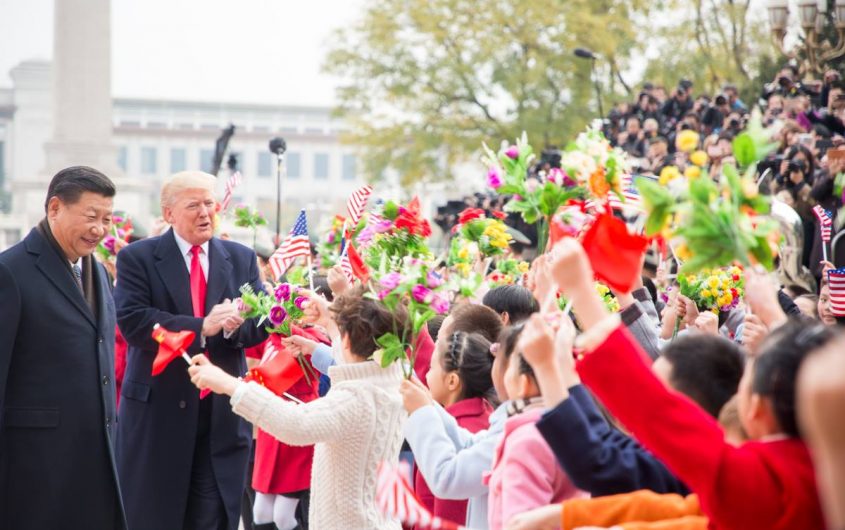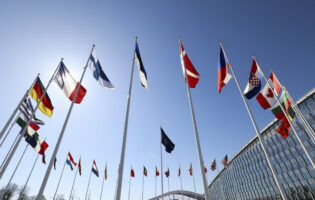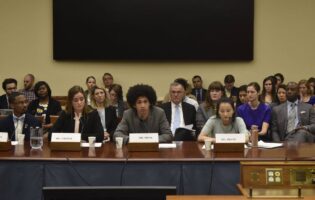
Official White House Photo by Shealah Craighead via Flickr
China Backlash: Toward a Transatlantic Agenda?

Noah Barkin
German Marshall Fund of the United States
Noah Barkin was a DAAD/AICGS Research Fellow from mid-March to mid-May 2019. Noah Barkin is a senior visiting fellow in the German Marshall Fund's Asia Program based in Berlin. Prior to joining GMF, he was a journalist who had reported from over 20 countries in 25-year career with Reuters, specializing in German and European political and economic issues. He served as Bureau Chief for Germany/Austria/Switzerland and in other senior writing, editing, and management roles in Paris, London, and New York. Noah has written a regular "Inside Europe" column for the New York Times and authored a book on the introduction of the euro. A native Californian, he has a BA in Political Science and French from UC Berkeley and a Master's in International Affairs from Columbia University.
During his fellowship at AICGS, Noah will be focusing on evolving policies toward China in the United States and Europe, exploring potential areas for cooperation and conflict.
At a time when the transatlantic relationship is under greater strain than at any period since World War II, there is one issue that should be pushing the United States and Europe closer together: China. On both sides of the Atlantic, concerns about China’s growing economic, political, and military ambitions have grown exponentially in recent years as President Xi Jinping has strengthened his grip over the country and laid out a set of ambitious multi-year plans and initiatives designed to restore China to past greatness. In Washington and many European capitals, there is shared anxiety today over a broad swathe of Chinese activities and policies. These range from the treatment of Western firms in China and a flurry of strategic, state-backed Chinese acquisitions abroad, to the spread of debt and political influence through Xi’s global infrastructure push, the Belt and Road Initiative (BRI), and the emergence of a pervasive Chinese surveillance state. China’s more assertive military posture in the Indo-Pacific and its human rights record, exemplified by the internment of over a million Muslims in the western region of Xinjiang, have deepened the collective sense of alarm.
In response, both the United States and Europe have taken significant steps to push back. In December 2017, the administration of U.S. president Donald Trump published a National Security Strategy that spoke of a new era of great power competition and accused China (and Russia) of seeking to shape a world “antithetical to U.S. values and interests.” Since then, the United States has adopted what administration officials refer to as a “whole of government” approach to China. Among other measures, it has overhauled legislation governing foreign investments, cracked down on academic exchanges, and more recently escalated its two-year-old trade war with Beijing by hiking tariffs on Chinese goods and putting Chinese telecommunications group Huawei—a poster child for the country’s rapid technological progress—on an export blacklist that severely restricts its access to vital U.S. technology.
Mirroring this shift has been a significant change in Europe’s approach to China. Over the past year, the EU has introduced an investment screening mechanism that makes it easier to vet Chinese acquisitions in Europe and it has begun debating changes to its industrial, competition, and procurement policies in response to what it sees as unfair Chinese practices. In January, the Federation of German Industries (BDI), an influential lobby group, produced a toughly-worded strategy paper that labelled China a “strategic competitor.” In March, the European Commission put out a paper of its own that described China as a “strategic rival” in some areas. And a month later, the EU threatened to walk away from its annual summit with China without a joint statement unless Beijing agreed to a series of pledges and timelines on opening up its economy, which it subsequently did. Spurred on by Washington, Brussels is also taking a closer look at security risks tied to Chinese participation in its next-generation 5G mobile networks, with an eye toward developing a set of common guidelines for member states.
Although both sides share many of the same concerns about China’s development, a large gap has opened up between how the United States and Europe understand and define the China threat.
One could be forgiven for interpreting these parallel shifts as a form of transatlantic policy convergence on China. But conversations I had with dozens of senior officials in the United States and Europe tell another story. Although both sides share many of the same concerns about China’s development, a large gap has opened up between how the United States and Europe understand and define the China threat. As a result, there is a significant risk that the two sides diverge in their policy responses, with China becoming a growing source of tension in the transatlantic relationship, rather than a unifying issue. Cooperation between the United States and Europe will be absolutely crucial in the years ahead if Western democracies are to offer coherent answers to an authoritarian China’s own vision of global governance, economic development, and rules around data privacy and artificial intelligence that will profoundly shape society in the twenty-first century. Indeed, one senior Trump administration official I spoke to acknowledged that America’s competition with China may ultimately succeed or fail based on what happens in Europe. But China policy under Trump is heading in a confrontational direction that Europe will struggle to follow. And bipartisan momentum in Washington behind this hard line suggests that the transatlantic divide on China may prove difficult to bridge even after Trump leaves office. As one senior EU official told me: “The Americans are out to beat, contain, confront China. They have a much more belligerent attitude. We believe they will waste a lot of energy and not be successful.”
China on the Agenda
Until recently, China played only a minor a role in a transatlantic dialogue that was focused on threats like Russia and Middle East terrorism. That has changed over the past years, with the United States ratcheting up its outreach to European allies on issues ranging from investment screening, to 5G and Belt and Road. The United States and Germany have held a biannual dialogue on China since 2016. And the Five Eyes intelligence alliance—grouping Australia, Britain, Canada, New Zealand, and the United States—began discussing China with other like-minded countries, including Germany and Japan, around the same time. Last year, I was told, the State Department named point people in European embassies to monitor China’s activities in the region and the China debate in European capitals. American diplomats told me that roughly 150 State Department employees, in both Washington and Europe, are currently spending part of their time on the issue. At the insistence of the United States, China was put on the agenda of a meeting of NATO foreign ministers in Washington in late March. And BRI could be discussed when G7 leaders gather in Biarritz in August. Recently, senior EU and U.S. officials agreed to meet on a quarterly basis to discuss joint responses to BRI. The unveiling of the EU-Asia Connectivity Strategy and the approval of U.S. Build Act legislation, both in October of last year, has opened the door to closer cooperation on infrastructure projects in the developing world. “The spectrum for coalition building is really quite big,” said one EU official after talks with American counterparts in April. Yet despite this flurry of activity, the hurdles to a broader transatlantic agenda on China remain formidable.
Mutual Distrust
Transatlantic tensions over a host of other issues, from trade and Iran, to military burden sharing and Europe’s (particularly Germany’s) appetite for Russian gas, have created profound distrust that will continue to hamper cooperation on China. The Trump administration has not spelled out where China fits on its transatlantic priority list, ratcheting up the pressure on European allies on a broad range of issues at the same time, while threatening them with trade tariffs. U.S. outreach has been clumsy and disjointed at times, particularly on the Huawei/5G issue, where brash opinions and threats have often eclipsed persuasive, fact-based arguments. Deepening the distrust have been signals from the president himself that undermine the narrative pushed by senior officials in his administration. Trump’s repeated suggestions that U.S. policy toward Huawei could be a bargaining chip in U.S. trade negotiations with China—and the precedent of his 2018 about-face on ZTE—have fueled suspicion about the administration’s motives and its end-game with China. One Washington-based European diplomat described the Trump administration’s approach to China as “all bluster and no strategy.” Deeply unpopular in Europe, Trump has polluted and obscured the nascent European debate over China policy. A recent poll published by the Atlantik-Brücke showed that 42 percent of Germans see China as a more reliable partner than the United States, compared to 23 percent who see the U.S. as the more trustworthy ally. In this environment, it is difficult for those European leaders who believe in the need for greater transatlantic cooperation on China to make a public case for it.
Forty-two percent of Germans see China as a more reliable partner than the United States, compared to 23 percent who see the U.S. as the more trustworthy ally.
The skepticism runs both ways. When speaking with administration officials in Washington, I did not pick up a great deal of appreciation for the shifts that have taken place in Europe, nor much patience with European complaints about the Trump team’s bullying approach to its allies. “Style does matter. You can break pottery along the way,” one person close to the administration told me. “But did a more charming approach work under Obama? I think we have been right to use hardball tactics.” In the corridors of power in Washington, Europe is still seen by many as divided, slow, and naive in its response to the China challenge. The steps that the EU hails as major victories—its investment screening legislation, for example—are dismissed as symbolic half-measures. It was pointed out to me repeatedly that half of EU member states still have no national legislation in place to vet foreign investments. The Italian government’s decision—despite active lobbying from European partners and the United States—to sign an MOU with China on BRI and Greece’s decision to join what has now become the 17+1 format has reinforced the idea in administration circles that Europe is hopelessly divided on China and will remain an unreliable partner.
Black and White
As the vigorous U.S. lobbying effort to convince European countries to exclude Huawei suggests, the administration sees 5G as an absolutely crucial issue. When it leaked in late April that the British government was prepared to allow Huawei to play a role in its next generation mobile network, a top official from the National Security Council was dispatched to London immediately to press for a rethink and Secretary of State Mike Pompeo showed up a week later to make the case publicly. “5G is where it all comes together,” one senior American official told me. Within the administration, Belt and Road is also seen in stark black-and-white terms, complicating cooperation with Europe in responding to it. In early April, weeks before Xi Jinping held his second BRI summit in Beijing, officials in the State Department tried to rally partners in Europe and elsewhere behind a statement condemning the project. But allies refused to go along, European diplomats told me. As Jeppe Tranholm-Mikkelsen, secretary-general of the European Council, told an audience in Washington in April: “The EU does not have an ideological position on BRI. We can’t just say no to all Chinese initiatives. That would be sending the wrong signal.” The splits on 5G and BRI echo the debate four years ago over the China-led Asia Infrastructure Investment Bank (AIIB). European countries ultimately ignored U.S. entreaties to boycott the bank, leaving Washington looking isolated.
Beneath the atmosphere of distrust lies a deep divide over the nature of the China challenge. In my conversations in Washington, I frequently heard the word “generational” in describing the challenge. “This is about adapting as a society, as an economy, our defense posture and our alliances,” the official close to the administration said. This Cold War-like view comes with a heavy dose of Sputnik-like panic that is pushing the U.S. debate on China—justified and overdue as it may be—in an extreme direction. In late March, a group of foreign policy hawks with ties to former White House adviser Steve Bannon announced the revival of a 1950s-era relic called the Committee on the Present Danger to raise awareness about what they called the “existential and ideological threat” posed by China. At their launch event, speakers warned in ominous tones that China was waging “constant war” against the United States. One suggested that more Americans had died in this war of economic attrition than in Vietnam or World War II. While it is easy to dismiss outlandish statements like this as the deranged rants of a political fringe, their message echoes within certain parts of the Trump administration. In late April, Kiron Skinner, the head of policy planning in the State Department, described the competition with China in racial terms, as a “fight with a really different civilization” that is “not Caucasian.” Skinner was widely condemned for her remarks. But they were less an aberration than a sign of where the debate is heading under the Trump administration.
Backlash against the Backlash?
Europe is in a very different place. Although senior officials in Brussels, Paris, and Berlin may bemoan what they see as a lack of interest in Washington in cooperating with Europe on China (last year when French president Emmanuel Macron urged closer cooperation, Trump reportedly told him that the EU was worse than China), it is unclear whether European leaders would really welcome a full-blown, institutionalized transatlantic agenda directed against Beijing. This would give the impression that the EU was taking sides in the dispute, a step European officials say in private that they want to avoid. It could endanger European commercial interests in China. And it would be a difficult sell to European publics. Indeed, as the Trump administration’s confrontation with China becomes more ideological and urgent, there is a risk that we see a backlash against the China backlash in Europe, with the political momentum behind robust pushback against Beijing fading. How a new European Commission positions itself on China and whether a fragile German government is willing to pay a price in order to forge a more united European and transatlantic stance will be key in this regard. So too will be Britain’s positioning on China post-Brexit. Once outside the EU, will the British government feel it can’t afford to put its economic ties with China at risk? Without London, Berlin, and Paris pulling together, it is difficult to imagine a loose European or transatlantic consensus on how to handle China.
Democrats to the Rescue?
Would a Democrat in the White House make a difference for transatlantic cooperation on China? On the surface, yes. All the main Democratic candidates for president have stressed the need to work more closely with America’s allies on China and a host of other foreign policy issues. A Democrat in the White House would instantly change the tone of the transatlantic debate. Outright hostility toward the EU, a hallmark of the Trump administration, would fade away. But it would be wrong to see a Democrat in the White House as a panacea for cooperation on China. Support for a hard line runs across party lines in Washington. And on issues like trade, human rights, and data privacy, some Democrats have criticized Trump for not being tough enough. To date, none of the leading candidates has spelled out in detail how they would approach the China challenge differently than the president.
It would be wrong to see a Democrat in the White House as a panacea for cooperation on China. Support for a hard line runs across party lines in Washington.
Whether China becomes an organizing principle of U.S. foreign policy going forward is not entirely clear. But the odds seem better than even. This means that Europe must prepare for a world in which it is increasingly seen by Washington through a China prism. “You cannot be on everyone’s side and on no one’s side,” one person who speaks regularly with administration officials told me. “it simply won’t be an option in a world where the U.S. is confronted with a peer competitor.”
Under a Democratic president we are likely to see a greater focus on domestic priorities—from healthcare and education to infrastructure spending. Democrats are likely to look to America’s allies to offset the costs of these programs by shouldering more of the security burden abroad. The pressure on Europe may have a different ring to it but it is not going away once Trump leaves office. Neither will the lingering bad taste of the Trump years. As one former Obama administration official put it, “Our allies have been traumatized by Trump and we will be hearing about him for a long time. They won’t be saying: ‘Glad to have you back, now let’s get down to business.’”
Conclusions
Alongside climate change, the rise of an authoritarian China, and how democratic nations respond to this rise, represents the biggest geo-political challenge of the twenty-first century. Cooperation between the United States and Europe—on reform of creaking postwar institutions of global governance, on the use of emerging technologies and big data, on global security challenges and human rights—will be vital in meeting this challenge. The United States and Europe are both alarmed about China’s development. Both sides have taken important steps over the past years to push back against a range of policies under Chinese president Xi Jinping that are seen as threats to their economic prosperity, strategic interests, and values. But at the moment there is a wide gap between how the United States and Europe perceive the China problem. And movement from both sides will be needed to prevent a damaging policy divergence that could grow over time, regardless of who is sitting in the White House. As long as U.S. policymakers continue to frame the China debate in Cold War terms—as a zero-sum fight that precludes any and all cooperation or compromise with Beijing—it will be difficult to keep the Europeans on side. In Europe, politicians will need to show more leadership on China, sacrificing advantages they have gleaned from bilateral relationships with Beijing, getting the business community behind their approach, and working overtime to ensure the EU remains united. The role played by Germany, Europe’s biggest economy and the one with the closest links to China, will be of paramount importance in this regard.
The coming year will be crucial. A new European Commission will need to show it can build on the momentum of the past year in holding China accountable. Europe and the United States will need to avoid a damaging rift over 5G and seek alternative solutions for their next-generation telecommunications networks if Huawei does not end up playing a central role. The two sides will need to work to overcome differences on data privacy, digital trade, and artificial intelligence. And they will need to collaborate if they are to offer developing countries a viable alternative to state-subsidized Chinese infrastructure projects. Should Trump follow through on his threat to impose auto tariffs on European and other allies, it could torpedo prospects for closer China cooperation under his administration altogether. Still, the case for closer transatlantic dialogue and cooperation on the China challenge remains compelling. Total convergence may be unrealistic. But if the two sides continue to diverge, the consequences will be profound.
Supported by the DAAD with funds from the Federal Foreign Office (FF).









